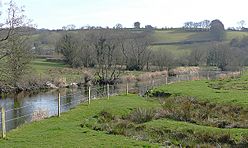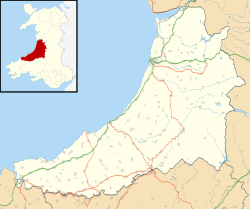Bremia (fort) facts for kids
Quick facts for kids Bremia |
|
|---|---|
 |
|
| Known also as | Llanio Roman Fort |
| Founded during the reign of | Vespasian |
| Founded | c. 73 - 77 AD |
| Abandoned | c. 125 AD |
| Place in the Roman world | |
| Province | Britannia |
| Nearby water | River Teifi |
| Stationed military units | |
| — Cohorts — | |
| II Asturum | |
| Location | |
| Coordinates | 52°11′23″N 3°59′05″W / 52.1896°N 3.9848°W |
| Place name | Llanio |
| Town | Llanddewi Brefi |
| County | Ceredigion |
| Country | Wales |
| Reference | |
| UK-OSNG reference | SN643564 |
| Site notes | |
| Discovery year | Late 17th century |
| Condition | Traces and crop marks |
| Controlled by | Scheduled Monument (SAM: CD129) |
Bremia is the name of an ancient Roman fort located in Llanio, West Wales. It is found in the Llanddewi Brefi area, which is part of Ceredigion. The Romans built this fort around 75 AD. It was used until about 120 AD during the time of Roman Wales.
The fort was built along Sarn Helen. This was an important Roman road that led north from another fort at Dolaucothi. Archaeologists have found five special stones at Bremia. These stones have writing on them. Two of them tell us that a group of soldiers called a cohort from Asturias in northern Spain was stationed there. The site also includes the remains of a Roman bathhouse. Both the bathhouse and the fort are now scheduled monuments. This means they are protected by law and cannot be disturbed.
Contents
What Was Bremia?
Finding the Name of the Fort
The name Bremia comes from a very old document. This document is called the Ravenna Cosmography. It was put together around 700 AD. The document lists many places known in the ancient world. It places Bremia between two other Roman sites. These were Gobannium (modern Abergavenny) and Alabum (modern Llandovery). Experts believe that the fort at Llanio is the place referred to as Bremia.
Discovering Bremia: Archaeological Clues
Early Discoveries at the Site
People first noticed ancient remains at Bremia in the 17th century. A man named Edward Lhuyd recorded them. He called the site 'Cae'r Castell', which means 'Castle Field'. He found old coins, bricks, and pieces of pottery there.
Modern Excavations and Findings
More detailed digs happened in 1888, 1961, 1969, and 1972. In the very dry summers of 1975 and 1976, something amazing happened. From the air, researchers could see outlines on the ground. These were called cropmarks. They showed the full size of the fort's walls and ditches. They also revealed some street patterns and other details.
The fort itself was almost square. It had rounded corners, which was typical for Roman forts. It measured about 130 meters (426 feet) across. This size suggests it could hold around 500 soldiers. Outside the fort, there was evidence of a vicus. This was a small civilian settlement that grew up next to the fort. It might have been home to another 1,000 people.
The Roman Bathhouse
In the late 1960s and early 1970s, archaeologists dug at the site of the bathhouse. They found the trenches where the building's foundations had been. However, most of the building materials were gone. It was hard to figure out the exact date the bathhouse was built.
Using Technology to See Underground
In 2005, a special survey was done. It used a gradiometer. This tool can detect things underground without digging. The survey was done about 75 meters (246 feet) west of the fort. It helped map out a Roman road running east-west from the fort. It also showed building plots and signs of small metalworking or burning sites.
Messages from the Past: Inscribed Stones
During the excavations, five different stones with writing were found. These are called inscribed stones. Two of them mention the group of soldiers who lived at the fort. This group was called the Second Cohort of Asturians. The stones read:
- 'COH II ASTVR ...' ("The Second Cohort of Asturians [...]")
- '...MIBVS ...COH II ASTVR' ("[...]mibus [...] the Second Cohort of Asturians")
The other three stones name different centurions. Centurions were Roman army officers. Their men had built parts of the fort. These stones read:
- 'ARTI MENNIVS PRIMVS' ("The century of Artius Mennius Primus [made this]")
- 'ARTI' ("The century of Artius [made this]")
- 'VERIONIS' ("The century of Verionus [made this]")
These stones give us direct clues about the soldiers and builders of Bremia.


